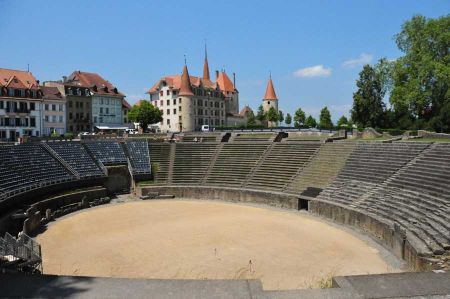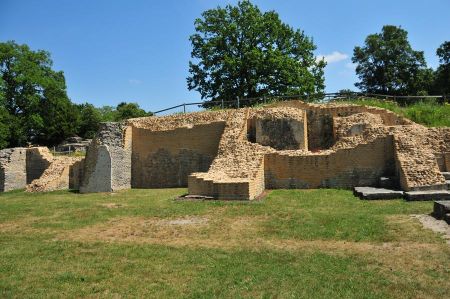Aventicum - Amphitheatre and Roman Theatre awaiting us
- Written by Portal Editor
At the time of the Roman Empire, Avenches, at the time called Aventicum, was the most important city on Swiss soil next to the trade route from the Rhone valley via Augusta Raurica to Germania.
We were curious what to expect in terms of the Roman cultural heritage in Avenches.
The founding of the Roman city of Colonia Pia Flavia Constan's Emerita Helvetiorum Fœderata, as the city's name was officially called, or Aventicum, as the indigenous population called their city, is today referred to a period around 15-13 BC. According to the older names research, the name Aventicum is said to be derived from a Helvetic source goddess Aventia; Today it is traced back to the celtic brook name Aventǐa, which is extended by the suffix -ǐko / -ǐcum.
Celtic settlers laid the foundation stone of Aventicum
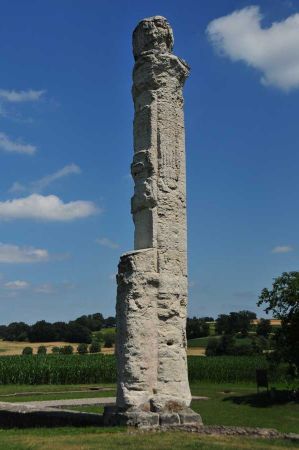 The roots of Avenches, however, go back to the Celts. A tribe of the Helvetii had built an oppidum at the height of the Bois de Châtel south of the later Roman village in the course of the 1st century BC.. This oppidum probably replaced an earlier oppidum on Mont Vully, which was abandoned at about the same time.
The roots of Avenches, however, go back to the Celts. A tribe of the Helvetii had built an oppidum at the height of the Bois de Châtel south of the later Roman village in the course of the 1st century BC.. This oppidum probably replaced an earlier oppidum on Mont Vully, which was abandoned at about the same time.
The first mention of the place can be found in the records of Tacitus, who already referred to the former settlement in 69 as the capital of the Helvetii (caput gentis). Under the influence of the Romans, Aventicum soon developed into a thriving commercial city with around 20,000 inhabitants and eventually became a bishopric.
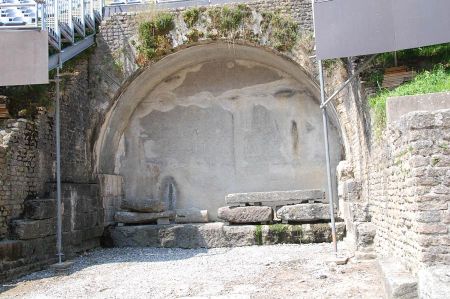 The decline of the Roman city began in the 3rd century AD, caused by the inner turmoil and looting of the Alemanni. As a result, the remaining inhabitants settled on the hill, where the present-day town of Avenches is located.
The decline of the Roman city began in the 3rd century AD, caused by the inner turmoil and looting of the Alemanni. As a result, the remaining inhabitants settled on the hill, where the present-day town of Avenches is located.
A new fortified settlement was re-founded in the 5th century on the grounds of the Roman city. Aventicum also remained during the troubled times and the constant threat of the Alamanni bishopric and possessed at least two churches (Saint-Martin and Saint-Symphorien). Until the middle of the 6th century, when Bishop Marius moved his seat to Lausanne, this even doesn’t mean the final end for Aventicum. Probably the place was still inhabited.
Ruins of the Roman city Aventicum
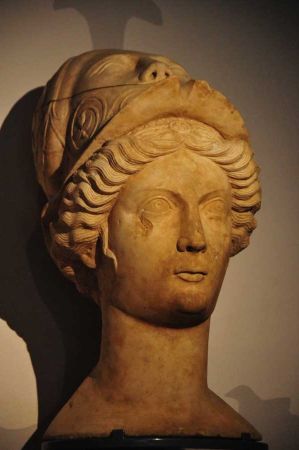 Important remains of the Roman city of Aventicum have been preserved, respectively excavated, restored and conserved. At the eastern exit of the historic city of Avenches there is the best-preserved amphitheater in Switzerland. Above the main entrance stands the former bishops tower from 11th century. The amphitheater hosts the well-known opera festival Festival Avenches Opéra.
Important remains of the Roman city of Aventicum have been preserved, respectively excavated, restored and conserved. At the eastern exit of the historic city of Avenches there is the best-preserved amphitheater in Switzerland. Above the main entrance stands the former bishops tower from 11th century. The amphitheater hosts the well-known opera festival Festival Avenches Opéra.
In the bishop's tower you will find the most interesting museum of Roman history with extensive finds of the era from the excavations, which today are still far from being completed.
Not far away, in the south of the former Aventicum stands the imposing Roman theater (Théâtre romain), from which numerous rows of seats and parts of the stage house and the grandstand base have been preserved.
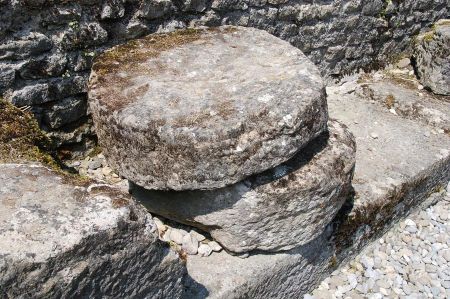 Other significant remains have been preserved from the Cigognier temple complex, the Capitol, the thermal baths and the former Roman enclosure wall. From the Cigognier temple just stands about 12 m high column on which storks nested earlier, which is why the temple got its name from the French word cigogne (stork).
Other significant remains have been preserved from the Cigognier temple complex, the Capitol, the thermal baths and the former Roman enclosure wall. From the Cigognier temple just stands about 12 m high column on which storks nested earlier, which is why the temple got its name from the French word cigogne (stork).
Anyone interested in Roman cultural history will not be disappointed. Especially the museum with its artefacts is worth the trip to Avenches.
Aventicum: Amphitheater and Roman Theater Lure You Back to Antiquity - more details
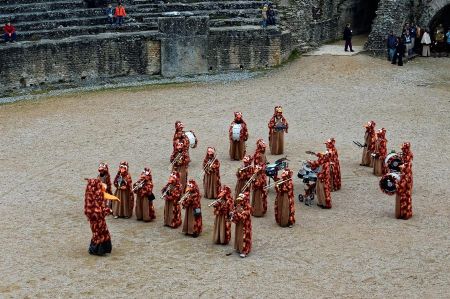 Are you planning a trip to Switzerland and want to experience history up close? Then you shouldn't miss Aventicum, the former capital of the Helvetii! Now known as Avenches, the town is home to some of the best-preserved Roman buildings in Switzerland – including an impressive amphitheater and a Roman theater that will transport you back to ancient times.
Are you planning a trip to Switzerland and want to experience history up close? Then you shouldn't miss Aventicum, the former capital of the Helvetii! Now known as Avenches, the town is home to some of the best-preserved Roman buildings in Switzerland – including an impressive amphitheater and a Roman theater that will transport you back to ancient times.
Aventicum – The Former Capital of the Helvetii
Aventicum was already an important place in Roman times. As the capital of the Helvetii, the town flourished under Roman rule and developed into an important center with over 20,000 inhabitants. Today, you can discover impressive relics of this era here.
Where is Aventicum today?
Aventicum is located in present-day Avenches, in the canton of Vaud, in western Switzerland. The charming little town is located between Lake Murten and Lake Neuchâtel, ideally situated for a day trip or as a stopover on a tour of Switzerland.
Historical Background – The Roman Heritage
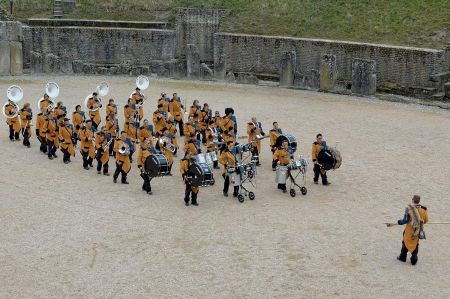 Founded in the 1st century AD, Aventicum quickly developed into a cultural and economic stronghold. The city walls, temples, bathing facilities, and public buildings still bear witness to its former splendor.
Founded in the 1st century AD, Aventicum quickly developed into a cultural and economic stronghold. The city walls, temples, bathing facilities, and public buildings still bear witness to its former splendor.
The Amphitheater of Aventicum
The absolute highlight: the amphitheater, built in the 2nd century. Gladiator fights, animal hunts, and public events once took place here. It could accommodate up to 16,000 spectators – a true spectacle then and now.
- Today it serves as a venue for concerts and theater performances.
- Access is possible year-round, sometimes even free of charge.
The Roman Theater – Stage of Antiquity
Somewhat quieter, but no less impressive, is the Roman Theater. It demonstrates that Aventicum was a cultural center. Dramas and comedies once took place here – entertainment for the upper classes of Roman society.
- Parts of the stage construction are still visible.
- The grounds are freely accessible.
Other Roman remains in Avenches
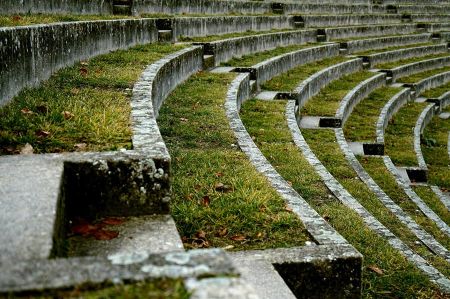 In addition to the amphitheater and theater, you will find:
In addition to the amphitheater and theater, you will find:
- Temple remains, including the sanctuary of Jupiter.
- Parts of the Roman city wall.
- Baths and mosaic floors.
- An aqueduct that provided water.
The Roman Museum in Avenches
In the Roman Museum, housed in the old castle, you'll gain fascinating insights into Roman life in Aventicum:
- Artifacts such as coins, ceramics, and weapons
- Virtual reconstructions of the city
- Especially recommended for families with children
Why a visit is especially worthwhile
- Unique ancient sites in a natural setting
- Historical atmosphere without mass tourism
- Ideal for photography, walks, and cultural tours
- A combination of history, nature, and Swiss hospitality
 Getting there and parking
Getting there and parking
- By car: Take the A1 between Lausanne and Bern, exit at Avenches.
- By train: Connections via Fribourg or Murten.
- There are ample parking spaces near the attractions.
Opening Hours and Admission
- Amphitheater & Theater: Mostly free to enter, no admission fee.
- Roman Museum: Open Tuesday to Sunday, low admission fee.
- Many sites are open later during the summer months.
Events and Activities 2025
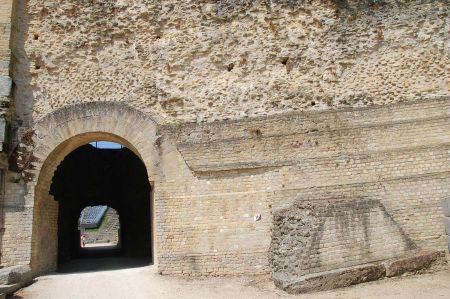 Avenches transforms into a stage of history in the summer:
Avenches transforms into a stage of history in the summer:
- Opera Festival in the amphitheater
- Ancient festivals with costumes, crafts, and shows
- Guided tours in historical costumes
Tips for families and school groups
- Numerous information panels with child-friendly explanations
- Puzzle rallies and interactive programs
- Special tours for schools
Culinary highlights of the region
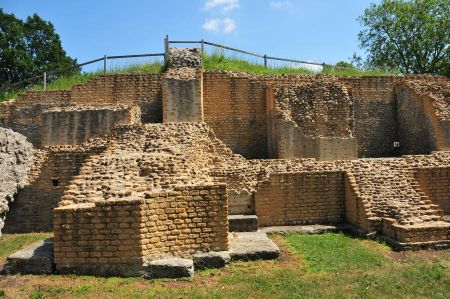 After a cultural excursion, indulgence is also a must:
After a cultural excursion, indulgence is also a must:
- Swiss specialties such as raclette and rösti
- Regional wines from Vaud
- Cafés with a view of the amphitheater
Conclusion
A visit to Avenches is like a journey back in time to Roman times – exciting, educational, and incredibly photogenic. Whether you love history or simply want to travel off the beaten track, Aventicum offers you a perfect combination of archaeology, nature, and culture.
FAQs
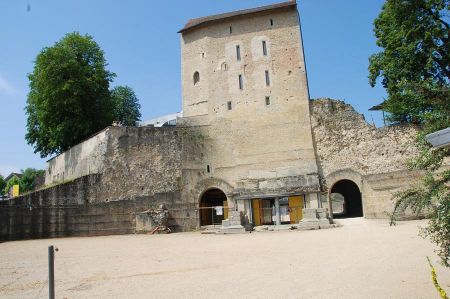 1. What is special about the Aventicum amphitheater?
1. What is special about the Aventicum amphitheater?
It is one of the largest Roman amphitheaters in Switzerland and is excellently preserved.
2. How much time should I plan for a visit?
You should plan at least half a day for the amphitheater, theater, and museum.
3. Can I book guided tours?
Yes, both public and private tours are offered regularly, including in German.
4. Is Avenches wheelchair accessible?
Many paths are wheelchair accessible, and the museum has an elevator.
5. Are there restaurants nearby?
Yes, numerous restaurants and cafés offer regional and international cuisine – many of them within walking distance.
Please read as well:
Through old town of Avenches from Murtensee Camping
Walk on Lake Murten - oaks and pines line the beach
-
 Roman Period of Switzerland Town Avenches
Roman Period of Switzerland Town Avenches
Roman Period of Switzerland Town Avenches
Roman Period of Switzerland Town Avenches
-
 Roman Period of Switzerland Town Avenches
Roman Period of Switzerland Town Avenches
Roman Period of Switzerland Town Avenches
Roman Period of Switzerland Town Avenches
-
 Roman Period of Switzerland Town Avenches
Roman Period of Switzerland Town Avenches
Roman Period of Switzerland Town Avenches
Roman Period of Switzerland Town Avenches
-
 Roman Period of Switzerland Town Avenches
Roman Period of Switzerland Town Avenches
Roman Period of Switzerland Town Avenches
Roman Period of Switzerland Town Avenches
-
 Roman Period of Switzerland Town Avenches
Roman Period of Switzerland Town Avenches
Roman Period of Switzerland Town Avenches
Roman Period of Switzerland Town Avenches
-
 Roman Period of Switzerland Town Avenches
Roman Period of Switzerland Town Avenches
Roman Period of Switzerland Town Avenches
Roman Period of Switzerland Town Avenches
-
 Roman Period of Switzerland Town Avenches
Roman Period of Switzerland Town Avenches
Roman Period of Switzerland Town Avenches
Roman Period of Switzerland Town Avenches
-
 Roman Period of Switzerland Town Avenches
Roman Period of Switzerland Town Avenches
Roman Period of Switzerland Town Avenches
Roman Period of Switzerland Town Avenches
-
 Roman Period of Switzerland Town Avenches
Roman Period of Switzerland Town Avenches
Roman Period of Switzerland Town Avenches
Roman Period of Switzerland Town Avenches
-
 Roman Period of Switzerland Town Avenches
Roman Period of Switzerland Town Avenches
Roman Period of Switzerland Town Avenches
Roman Period of Switzerland Town Avenches
-
 Roman Period of Switzerland Town Avenches
Roman Period of Switzerland Town Avenches
Roman Period of Switzerland Town Avenches
Roman Period of Switzerland Town Avenches
-
 Roman Period of Switzerland Town Avenches
Roman Period of Switzerland Town Avenches
Roman Period of Switzerland Town Avenches
Roman Period of Switzerland Town Avenches
-
 Roman Period of Switzerland Town Avenches
Roman Period of Switzerland Town Avenches
Roman Period of Switzerland Town Avenches
Roman Period of Switzerland Town Avenches
-
 Roman Period of Switzerland Town Avenches
Roman Period of Switzerland Town Avenches
Roman Period of Switzerland Town Avenches
Roman Period of Switzerland Town Avenches
-
 Roman Period of Switzerland Town Avenches
Roman Period of Switzerland Town Avenches
Roman Period of Switzerland Town Avenches
Roman Period of Switzerland Town Avenches
-
 Roman Period of Switzerland Town Avenches
Roman Period of Switzerland Town Avenches
Roman Period of Switzerland Town Avenches
Roman Period of Switzerland Town Avenches
-
 Roman Period of Switzerland Town Avenches
Roman Period of Switzerland Town Avenches
Roman Period of Switzerland Town Avenches
Roman Period of Switzerland Town Avenches
-
 Roman Period of Switzerland Town Avenches
Roman Period of Switzerland Town Avenches
Roman Period of Switzerland Town Avenches
Roman Period of Switzerland Town Avenches
-
 Roman Period of Switzerland Town Avenches
Roman Period of Switzerland Town Avenches
Roman Period of Switzerland Town Avenches
Roman Period of Switzerland Town Avenches
-
 Roman Period of Switzerland Town Avenches
Roman Period of Switzerland Town Avenches
Roman Period of Switzerland Town Avenches
Roman Period of Switzerland Town Avenches
-
 Roman Period of Switzerland Town Avenches
Roman Period of Switzerland Town Avenches
Roman Period of Switzerland Town Avenches
Roman Period of Switzerland Town Avenches
-
 Roman Period of Switzerland Town Avenches
Roman Period of Switzerland Town Avenches
Roman Period of Switzerland Town Avenches
Roman Period of Switzerland Town Avenches
-
 Roman Period of Switzerland Town Avenches
Roman Period of Switzerland Town Avenches
Roman Period of Switzerland Town Avenches
Roman Period of Switzerland Town Avenches
-
 Roman Period of Switzerland Town Avenches
Roman Period of Switzerland Town Avenches
Roman Period of Switzerland Town Avenches
Roman Period of Switzerland Town Avenches
-
 Roman Period of Switzerland Town Avenches
Roman Period of Switzerland Town Avenches
Roman Period of Switzerland Town Avenches
Roman Period of Switzerland Town Avenches
-
 Roman Period of Switzerland Town Avenches
Roman Period of Switzerland Town Avenches
Roman Period of Switzerland Town Avenches
Roman Period of Switzerland Town Avenches
-
 Roman Period of Switzerland Town Avenches
Roman Period of Switzerland Town Avenches
Roman Period of Switzerland Town Avenches
Roman Period of Switzerland Town Avenches
-
 Roman Period of Switzerland Town Avenches
Roman Period of Switzerland Town Avenches
Roman Period of Switzerland Town Avenches
Roman Period of Switzerland Town Avenches
-
 Roman Period of Switzerland Town Avenches
Roman Period of Switzerland Town Avenches
Roman Period of Switzerland Town Avenches
Roman Period of Switzerland Town Avenches
-
 Roman Period of Switzerland Town Avenches
Roman Period of Switzerland Town Avenches
Roman Period of Switzerland Town Avenches
Roman Period of Switzerland Town Avenches
-
 Roman Period of Switzerland Town Avenches
Roman Period of Switzerland Town Avenches
Roman Period of Switzerland Town Avenches
Roman Period of Switzerland Town Avenches
-
 Roman Period of Switzerland Town Avenches
Roman Period of Switzerland Town Avenches
Roman Period of Switzerland Town Avenches
Roman Period of Switzerland Town Avenches
-
 Roman Period of Switzerland Town Avenches
Roman Period of Switzerland Town Avenches
Roman Period of Switzerland Town Avenches
Roman Period of Switzerland Town Avenches
-
 Roman Period of Switzerland Town Avenches
Roman Period of Switzerland Town Avenches
Roman Period of Switzerland Town Avenches
Roman Period of Switzerland Town Avenches
-
 Roman Period of Switzerland Town Avenches
Roman Period of Switzerland Town Avenches
Roman Period of Switzerland Town Avenches
Roman Period of Switzerland Town Avenches
-
 Roman Period of Switzerland Town Avenches
Roman Period of Switzerland Town Avenches
Roman Period of Switzerland Town Avenches
Roman Period of Switzerland Town Avenches
https://www.alaturka.info/en/switzerland/zurich/4877-aventicum-amphitheatre-and-roman-theatre-awaiting-us#sigProId35d4471c50
